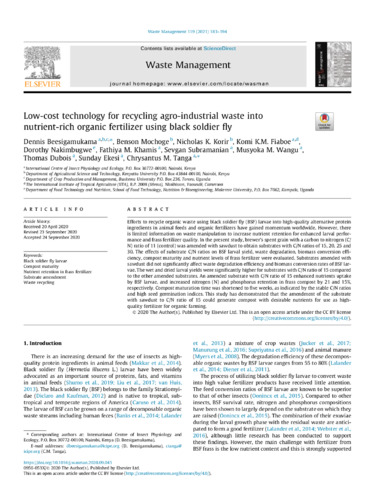Low-cost technology for recycling agro-industrial waste into nutrient-rich organic fertilizer using black soldier fly
Abstract
Efforts to recycle organic waste using black soldier fly (BSF) larvae into high-quality alternative protein ingredients in animal feeds and organic fertilizers have gained momentum worldwide. However, there is limited information on waste manipulation to increase nutrient retention for enhanced larval performance and frass fertilizer quality. In the present study, brewer’s spent grain with a carbon to nitrogen (C/N) ratio of 11 (control) was amended with sawdust to obtain substrates with C/N ratios of 15, 20, 25 and 30. The effects of substrate C/N ratios on BSF larval yield, waste degradation, biomass conversion efficiency, compost maturity and nutrient levels of frass fertilizer were evaluated. Substrates amended with sawdust did not significantly affect waste degradation efficiency and biomass conversion rates of BSF larvae. The wet and dried larval yields were significantly higher for substrates with C/N ratio of 15 compared to the other amended substrates. An amended substrate with C/N ratio of 15 enhanced nutrients uptake by BSF larvae, and increased nitrogen (N) and phosphorus retention in frass compost by 21 and 15%, respectively. Compost maturation time was shortened to five weeks, as indicated by the stable C/N ratios and high seed germination indices. This study has demonstrated that the amendment of the substrate with sawdust to C/N ratio of 15 could generate compost with desirable nutrients for use as high-quality fertilizer for organic farming.

